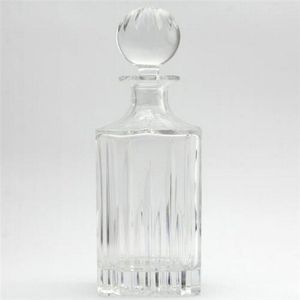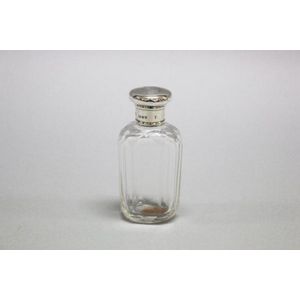Georgian hobnail liquor decanter with sunburst stopper
You must be a subscriber, and be logged in to view price and dealer details.
Subscribe Now to view actual auction price for this item
When you subscribe, you have the option of setting the currency in which to display prices to $Au, $US, $NZ or Stg.
- Lead Glass - Lead glass, also known as lead crystal, is a type of glass that contains a high percentage of lead oxide. This gives lead glass a high refractive index, making it sparkle and giving it a distinct "crystal" appearance. Lead glass is often used to make high-end wine glasses, decanters, and other decorative objects. Lead crystal is prized for its clarity, brilliance, and weight, as well as its beautiful, intricate designs.
- Georgian - As an English stylistic period, Georgian is usually taken to cover the period from George I (1714) to the Regency of Prince George (1811-20), although the period from 1800 to 1830 is sometimes designated as the Regency period. During the Georgian period the great English cabinetmakers and designers such as Chippendale, Hepplewhite, Adam Sheraton etc., were all active.
Therefore there isn't a single 'Georgian style' as such and to say something is 'Georgian', usually means it was made between 1714 and 1830. This assumes we discount George V and George VI, both being from the 20th century.
The styles popular at the time of each reign were:
George I (1714-1727) saw out the last years of the Baroque period.
George II (1727-1760) reigned during the Rococo period.
George III (1760-1820) saw the last gasp of the Rococo, all of the early Neo-Classic 'Adam style' and most of the later neo-Classic 'Regency style'.
George IV (Prince Regent 1820-1830)encompassed the last of the 'Regency' style.
William IV's reign (1830-1837) was something of a no man's land (stylistically) and he wasn't a 'George' anyway. He covered the last glimmerings of 'Regency' and the start of the 'Victorian' style. - Lead Crystal - The first clear glass, called cristallo was invented during the 15th century in Venice. Prior to this the glass had a slight yellow or greenish colour as a result of iron ore impurities with the glass. 'Cristallo' was heavily exported .
In 1675, while attempting to counter the Venetian dominance of the glass market, British glassmaker George Ravenscroft invented lead glass, by adding lead oxide to to replace the calcium content in glass.
The new glass he created was quicker to melt, and stayed moulten longer, making it easier to work. More importantly, it had a higher refractive index, adding to its brilliance and beauty, especially when embellished with wheel cut decoration.
Lead crystal, is variety of lead glass, with a higher percentage of lead oxide than lead glass.
Ravenscroft's patent on lead crystal expired in 1681, and more glass makers were able to take advantage of his invention. The expansion in production resulted in England to overtaking Venice as the centre of the glass industry in the eighteenth and nineteenth centuries.
This item has been included into following indexes:
Visually similar items

A Georgian heavy cut lead crystal decanter with triple ring neck and mushroom stopper. C.1810. Height 21 cm

Waterford Crystal 'Marquis' decanter having clear cut detail, stamped with an acid etched stamp 'Marquis by Waterford' to the base. Condition: good, minor wear to the base, height 24.5 cm

Antique perfume bottle with sterling silver cap, marked London, TJW, 1896, approx 10 cm high

Pair of antique French decanters, each approx 29 cm high (2)
